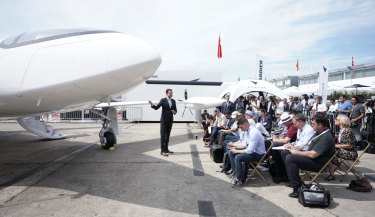Facing climate guilt, plane makers promise cleaner flights - someday
disallowed/business/companies/facing-climate-guilt-plane-makers-promise-cleaner-flights-someday-20190621-p51zvt.html?utm_medium=Social&utm_source=Twitter#Echobox=1561078841Battery-powered planes, solar planes, hydrogen planes - jet makers are working on myriad ways to make flying less damaging to the planet. Yet clean flying on a mass scale remains decades away.
That's despite growing pressure from regulators and from a blossoming environmental movement to shun air travel altogether .
The problem, argue aviation powerhouses gathered this week at the Paris Air Show, is that growing world populations and economies mean that the number of planes in the sky could double in the next 20 years. And today's clean-aviation technologies aren't ready to keep up.
Electrified flight
Carmakers figured out how to go electric, so why can't we do it in the air, too?
Weight, altitude and storage, primarily. A mid-sized passenger plane weighs 100 times as much as a mid-sized car, and there is no battery system currently strong enough to lift a machine that size off the ground and keep it there.
So the dozens of companies working on electric planes - including Boeing and Airbus - are starting small.
Israeli company Eviation unveiled its 9-seat, all-electric plane named Alice at the air show, and won its first customer, US-based Cape Air. It hopes to get the plane certified and in service by 2022.
With a sleek nose, futuristic aura and 3.8 tonnes of batteries built into the frame, the plane can theoretically fly up to 540 nautical miles (1,046 kilometres), or a bit more than a Sydney to Brisbane flight. But it travels at less than half the speed of fuel-powered planes travelling such routes.
Eviation CEO Omer Bar-Yohay unveiled the company's 'Alice' electric aircraft during the 53rd International Paris Air Show this week.CREDIT:BLOOMBERG
Urban air taxis may be the first widespread use of electric aviation. Uber wants to start flying them by 2023 around Houston and Los Angeles, but needs to overcome technology and certification challenges first.
Safety is paramount, and batteries notably heat up.
The CEO of the company that makes Alice's electric motors, Roei Ganzarski of magniX, notes that jet fuel too "is very combustible. But just like there are safety precautions on how to store fuel and use fuel on aircrafts, there will be safety precautions on how to use and store batteries on an aircraft. And so that too will be certified and tested way before it flies with passengers."
Hybrid options
Until someone solves the battery weight problem, most of the industry is betting for now on some middle-ground solution instead, combining electric power and traditional jet fuel. Analysts say some 200 hybrid projects are under development.
Some use electric technology for takeoff and standard fuel for cruising. United Technologies announced this week that it's aiming to have a "city hopper" regional passenger hybrid jet within three years that would save 30 per cent of fuel that way.
That's also the idea behind Voltaero, started by a former Airbus technology chief, Jean Botti.
Botti wants to see it enter in service by 2021 or 2022, and says they've had interest from operators in Scotland, Norway and Switzerland for regional jets.
"Pure electric airplanes can be nice for training pilots, a nice little toy I can play with. But when it comes time for commercial and you want to have some range, hybrid is the solution," he said.
Manufacturers are also looking at recycling fuels or mixing them - adding synthetic fuel or renewable biofuel to kerosene to reduce its carbon footprint - or using hydrogen, a far-off but increasingly talked-about option.
Paying to pollute
The industry is also looking for financial ways to ward off regulators and retain environmentally conscious passengers.
A UN-driven system called CORSIA will allow airlines to buy credits to compensate for, or "offset," their emissions. But critics say CORSIA - or Carbon Offsetting and Reduction Scheme for International Aviation - isn't ambitious or punitive enough.
Germany's Lufthansa is among the airlines that let customers offset their flights by calculating how much damage they are doing to the environment and paying a voluntary tax.
It's the grand challenge of our generation. I don't think we have the solution.
United Technologies technology chief Paul EremenkoLufthansa works through Switzerland-based MyClimate to calculate how much passengers should pay.
But climate-savvy travellers note that Lufthansa charges less than MyClimate itself calculates, because it ignores an effect called "radiative forcing" that experts say doubles the climate impact of airline emissions at high altitude.
Qantas also has a carbon pollution offsetting program, which it started in 2007 and claims "is the largest of any airline".
Reality check
While the aviation industry is doing more than ever to lower emissions, at times it seems overwhelmed by the task, or unwilling to dramatically rethink the business.
Even if Europeans shun planes for cleaner high-speed trains, most travellers in the US and Australia don't have that option, Asia's growing middle class will increasingly take to the skies, and low-cost airlines are making air travel ever more accessible.
"It's the grand challenge of our generation. I don't think we have the solution," said Paul Eremenko of United Technologies.
The airline industry has committed to halving greenhouse gas emissions by 2050 compared with 2005 levels. That's far short of the target increasingly set by governments and backed by scientists to almost eliminate emissions by 2050.
Boeing's Chief Technology Officer Greg Hyslop says the industry's own targets are a "very hard problem".
"It's going to be an all of the above approach," he said. "Because we don't know how we're going to solve that exactly."
AP
- Forums
- ASX - By Stock
- PLS
- re:Lithium demand surge
re:Lithium demand surge, page-2566
-
- There are more pages in this discussion • 532 more messages in this thread...
You’re viewing a single post only. To view the entire thread just sign in or Join Now (FREE)
Featured News
Add PLS (ASX) to my watchlist
 (20min delay) (20min delay)
|
|||||
|
Last
$2.89 |
Change
-0.005(0.17%) |
Mkt cap ! $8.714B | |||
| Open | High | Low | Value | Volume |
| $2.91 | $2.93 | $2.86 | $45.66M | 15.78M |
Buyers (Bids)
| No. | Vol. | Price($) |
|---|---|---|
| 50 | 291811 | $2.88 |
Sellers (Offers)
| Price($) | Vol. | No. |
|---|---|---|
| $2.89 | 441882 | 75 |
View Market Depth
| No. | Vol. | Price($) |
|---|---|---|
| 35 | 173536 | 2.880 |
| 63 | 540123 | 2.870 |
| 45 | 570641 | 2.860 |
| 111 | 760096 | 2.850 |
| 22 | 389766 | 2.840 |
| Price($) | Vol. | No. |
|---|---|---|
| 2.890 | 426238 | 55 |
| 2.900 | 663586 | 40 |
| 2.910 | 375602 | 29 |
| 2.920 | 592966 | 27 |
| 2.930 | 236054 | 16 |
| Last trade - 15.24pm 23/07/2024 (20 minute delay) ? |
Featured News
| PLS (ASX) Chart |
The Watchlist
I88
INFINI RESOURCES LIMITED
Charles Armstrong, CEO & MD
Charles Armstrong
CEO & MD
Previous Video
Next Video
SPONSORED BY The Market Online






